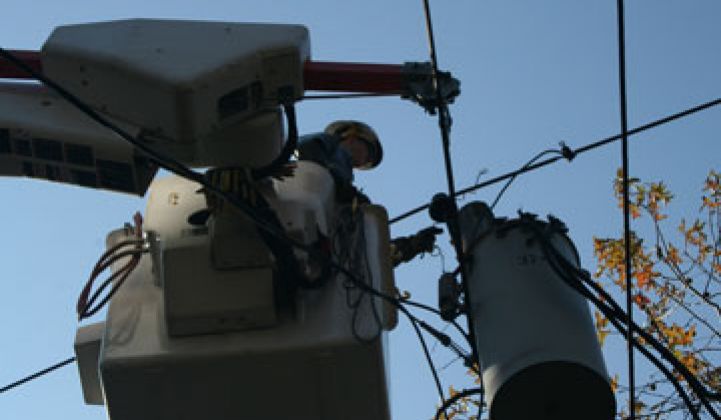Sensus’ smart meters were sidelined in PECO’s territory just weeks before Hurricane Sandy slammed into the East Coast. But a Sensus communication network connecting the 186,000 smart meters that had been installed up to that point was already up and running.
Even though the meter deployment is only about 10 percent complete, PECO saw notable advantages to its advanced metering deployment, compared to its advanced meter reading, or AMR, system that has been in place for years.
During the storm, PECO lost visibility to about one-third of its AMR meters, according to Barry Cole, director of IT for PECO, which is an Exelon company. For the smart meter network, connections went down on about 3 percent of the meters. “Because of the redundancy, that’s a huge difference,” Cole said of the Sensus network.
The utility was not quick to tout the benefits from its technology after a public relations uproar when a handful of its smart meters overheated, resulting in a few fires earlier in the year. But the one-way AMR system, which has been in place for years, relies on thousands of message communication concentrators (MCC), which collect signals for the mesh radio metering system.
The Sensus communication layer, on the other hand, relies on about 160 tower gateway systems, which work like cell towers and connect to smart meters via point-to-point communication over licensed spectrum, versus a mesh topology over unlicensed 900 MHz that most other meter communications use. The result is that if meters don’t rely on each other to move signals around and if a tower goes out, restoring that one tower will restore more meters. In comparison, PECO saw 500 of its MCCs go down, which means 500 different truck rolls, versus 30 tower gateways.
With AMR, PECO could ping a meter to verify if it had power. But in reality, it wasn’t the meter it was talking to, but rather the MCC. With two-way digital smart meters, utilities can communicate with individual meters for more visibility into real-time outages.
Of course, smart meters don’t stop downed trees and flooded equipment. About 850,000 lost power in PECO’s territory during Sandy, accounting for more than half its 1.6-million customer base. During Hurricane Irene, about 500,000 PECO customers lost power.
However, in the days after Sandy, the utility calculated that there were 50,000 customers who had a far shorter outage due to the utility's smart grid deployment, which include upgrades to the OMS to better communicate with AMR meters and the AMI technology.
With the two-way meters, the utility can determine if its a single home going out versus a transformer that might have taken down part of an entire neighborhood. It can also confirm momentary outages, versus power that has gone out entirely.
Before AMI, the utility could pull information from non-responding AMR meters into its outage system then send a crew out to verify if power has come back on. During Sandy, the utility saw more than 4,257 cases of using the meters -- instead of a crew -- to determine if power was back on. That figure is nearly double the figure from Hurricane Irene, where just AMR was linked into the OMS. “That’s 4,257 crews we didn’t need to dispatch,” said Cole. Those are crews that can then go somewhere else, such as to a transformer to restore power to various homes. The utility could also tell more quickly which outages were primary events, involving transformers or feeders, rather than single outages.
In total, PECO estimated it had more than 6,000 avoided or more effective truck rolls after Hurricane Sandy. At Baltimore Gas & Electric, the utility noted in its blog that its partial smart meter deployment (also about 10 percent) also allowed for more targeted truck rolls. Jeanette Mills, chief customer officer at BGE, noted that when a feeder has been fixed, they still have to check with individual customers, and traditionally about two-thirds of customers do not pick up the phone to confirm if their power is back. With smart meters, the utility can check without needing someone to be home or sending a truck out.
PECO still has the bulk of its smart meters to deploy, and it will be making upgrades to its decade-old OMS as those meters come on-line. The utility is also installing GIS, which should help with more accurate storm forecasting. Because PECO has been using AMR for so long, “For us, it’s continuing to refine and extend for the numbers you’re looking at,” said Cole, who will be crunching data to find lessons learned for the next storm.
Although no one hopes for a storm that brings the devastation of Sandy, politicians and customers will be asking hard questions about how utilities can be better prepared next time. “We’re still recovering,” Cole admitted. “But we’re pretty excited to realize the benefits with the availability of AMI.”
